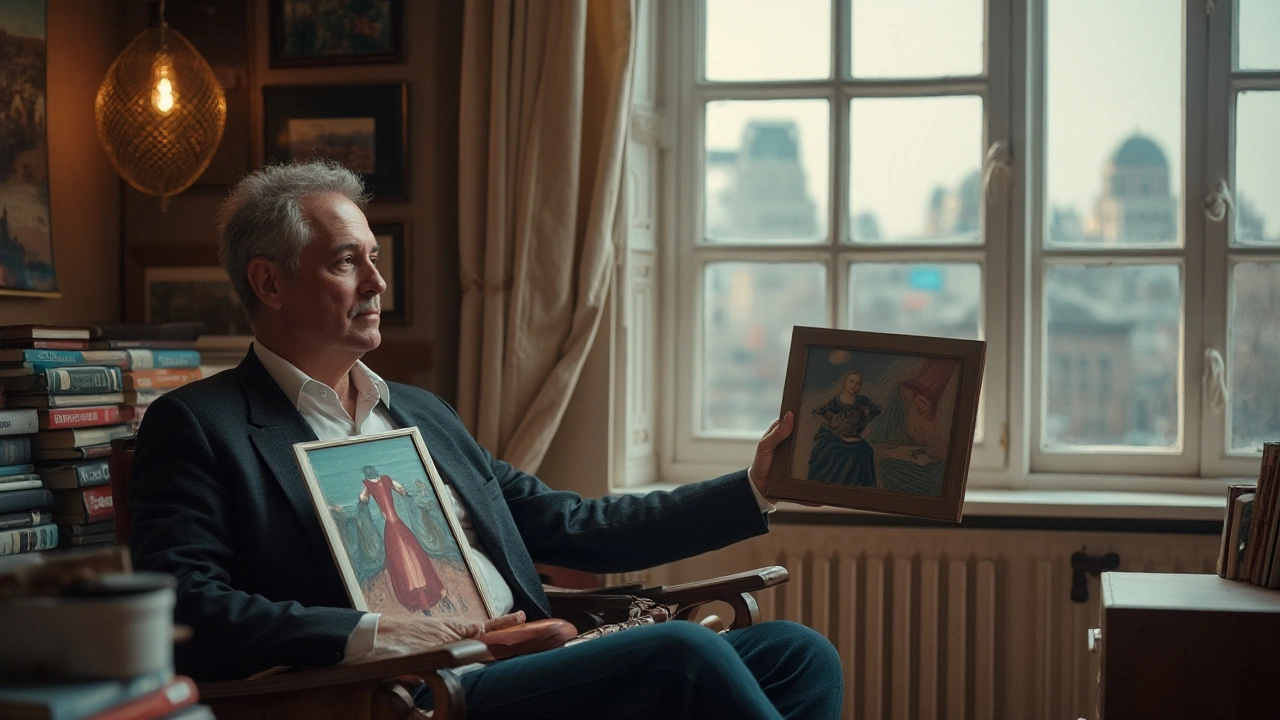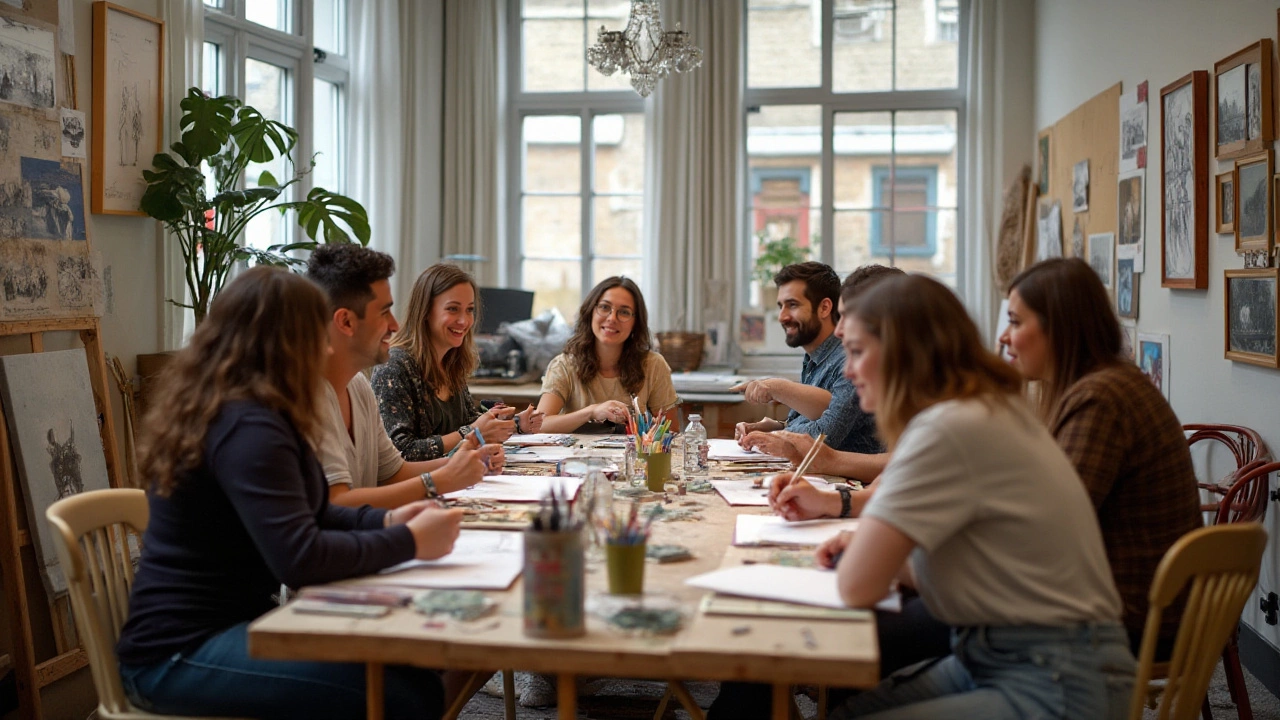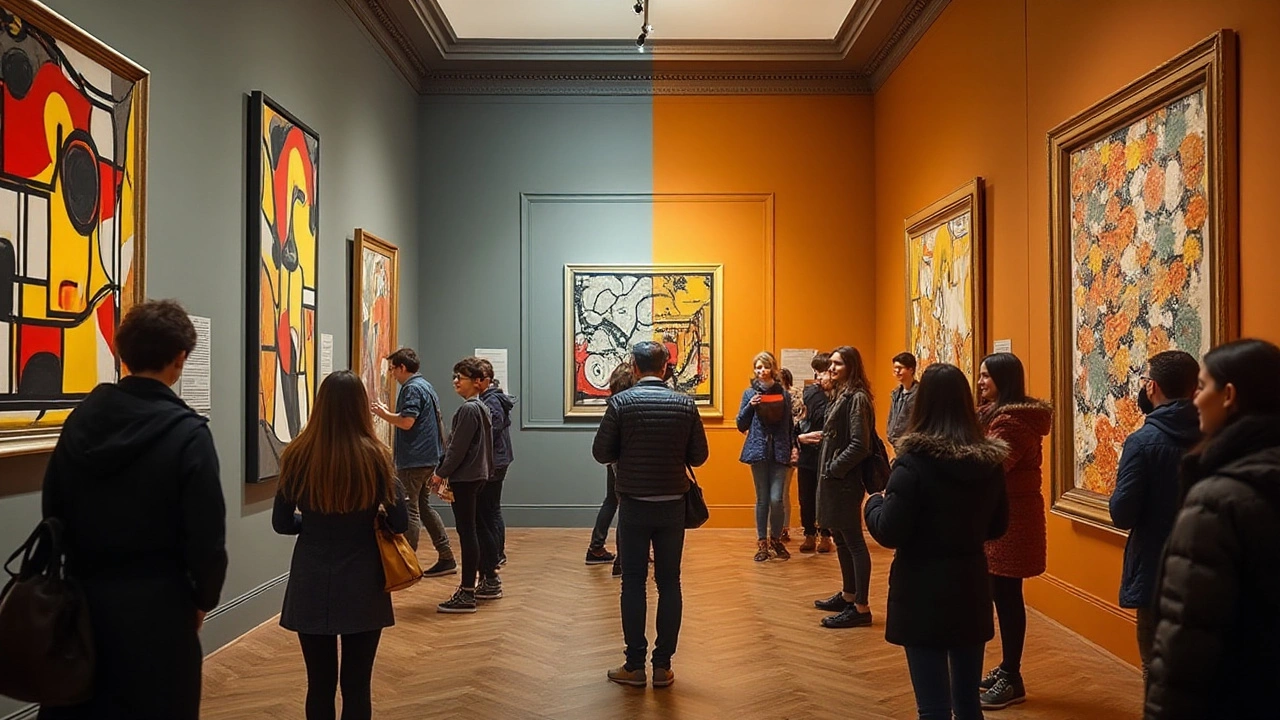The art world is a tapestry of diverse movements, each with unique flair. It's easy to trip over terms like 'contemporary' and 'modern' without fully grasping their nuances. While these terms are often used interchangeably, in the realm of art, they hold distinct meanings.
The lines between contemporary and modern art can appear blurred at first glance. Yet, by delving into their histories and core attributes, one starts to see how these categories distinctly paint the landscape of our artistic heritage.
In this exploration, we take a magnifying glass to each movement, uncovering what sets them apart, the visionaries who sculpted their paths, and their impact on how we interpret artistic expression today.
- Defining Modern Art
- Characteristics of Modern Art
- Defining Contemporary Art
- Characteristics of Contemporary Art
- Key Differences Between Modern and Contemporary Art
- Notable Artists from Each Movement
Defining Modern Art
Modern art is more than just a timeline in the history of visual culture; it's a profound transformation in how art is created and perceived. This movement, generally accepted to have spanned from the late 19th century to the mid-20th century, was a rebellion against the established norms and traditions of the art world at the time. Artists began to explore unprecedented ways of seeing and with new ideas about the nature of materials and functions of art. During this period, the idea of progress was at its height, which mirrored the rapid industrial advances of the era.
The essence of modernism is deeply rooted in the spirit of questioning. Artists, moved by the changing times, reframed traditional artistic forms like painting, sculpture, and architecture. This was not just about color and shape but about pushing the boundaries of what art could depict. The industrial revolution and urban growth inspired artists to capture the ever-evolving world around them with fresh eyes. A notable character of modern art is its embrace of abstraction and varied perspectives, enabling creators to express more than the tangible reality.
One cannot discuss modern art without mentioning movements such as Impressionism, Expressionism, and Cubism. Each added a unique voice to this multifaceted chorus of innovation. For instance, Impressionist painters like Claude Monet employed light and color to paint everyday scenes in ways that emphasized movement and the passage of time. Likewise, Picasso's Cubism defied the traditional viewpoint, representing subjects from multiple angles to convey more depth. As Herbert Read once eloquently put it,
‘Modern art is the art which strives to reflect the spirit of the age, which is ceaseless change and movement.'
The modern art era also introduced the idea that anything could be art. Marcel Duchamp's infamous 'Fountain,' a simple urinal presented as an artwork, challenged the very notion of artistry. This audacity defined a new era where the artist's intention and conceptual foundation took precedence over the technical craftsmanship. Such shifts paved the way for movements like Dada and Surrealism. The art was deeply influenced by the psychological theories of Freud and Jung, delving into the subconscious and dream imagery, allowing the human psyche to paint its narrative.
In conclusion, modern art represents a complex confluence of innovation, cultural reflection, and avant-garde expression. It rejects prior stylistic constraints and embraces a more liberated form of creativity. This period not only altered how art was created but also transformed the audience's relationship with art, encouraging viewers to think critically and see beyond the canvas.
Characteristics of Modern Art
Modern art is an umbrella term that refers to art produced during a specific period, roughly between the 1860s and the 1970s. This era was marked by a paradigm shift as artists began to break away from the traditional styles and techniques that had dominated the art world for centuries. The embrace of experimentation is indeed one of the most defining traits of modern art. An abandonment of the past and the thirst for the new propelled many artists to chart unfamiliar territories. Artists were not just painting what they saw; they were also painting how they felt, and this emotional depth became a vital component of the art form.
Key traits of modern art include an emphasis on innovation, a focus on the use of new materials and techniques, and often, a direct engagement with social issues and the human condition. Modern art is marked by a departure from realism to embrace abstraction, as seen in movements like Cubism, Futurism, and Abstract Expressionism. Pablo Picasso and Georges Braque, for instance, deconstructed subjects in their visionary Cubist works, challenging traditional perspectives. This period also saw the rise of significant figures like Vincent van Gogh, whose emotional and bold brushwork opened new avenues for expression.
"Art is not what you see, but what you make others see," said Edgar Degas, illustrating the sentiment of this transformative period.
Modern art was also a reaction to a world in flux, including the dramatic changes brought on by industrialization, urbanization, and political upheaval. The sensibilities of modern artists were often reflective of their complex and rapidly changing world, pushing the boundaries of what art could be. The subject matter expanded dramatically, with artists exploring industrial landscapes, the fast pace of city life, and even the subconscious mind, as demonstrated by Surrealism. There was often an explicit intention to provoke or challenge the audience, whether through shocking subject matter or radical techniques. As a result, exhibitions became arenas of debate about art's purpose and future direction.
Interestingly, modern art also laid the groundwork for the plethora of diverse styles that define contemporary art today. By rejecting strict adherence to realism and embracing personal vision, artists like Claude Monet and Wassily Kandinsky set a new precedent. Wholly emotional experiences took precedence over mere imitation. This period marked a profound exploration of color, form, and composition to express an artist's inner vision. Movements like Impressionism, which focused on light and momentary impressions, challenged traditional perceptions and the notion of what art should depict, ultimately helping to democratize the art world of routine and predictability.

Defining Contemporary Art
When stepping into the world of contemporary art, one might imagine a spectrum of expressions that reflects the kaleidoscope of our current world. This art form is vividly distinct from its predecessors as it encapsulates the spontaneous, often turbulent spirit of recent decades. Typically, contemporary art refers to works produced in the late 20th century up until the present day. Its broad swathe includes painting, sculpture, photography, installation, performance, and digital art, veering away from traditional approaches and embracing experimental forms.
The beauty of contemporary art lies in its ability to incorporate global dialogues. It is an art of concepts and ideas, often probing societal themes like identity politics, globalization, technology, and environmental issues. This genre doesn’t just stop at aesthetic; it thrives on engaging the viewer in conversation. A catalyst for discussion, many pieces invite the observer to rethink established norms. This democratization of art has opened doors to an unprecedented variety of cultural narratives.
One notable insight comes from the renowned curator Hans Ulrich Obrist who once stated,
"Contemporary art is a much larger phrase that means much more than just 'art of today.' It encompasses all the artistic trends and perspectives at work in the present moment, across borders and cultures."Unlike more rigidly defined movements, contemporary art is refreshingly inclusive, drawing on influences ranging from everyday life to untouched futuristic landscapes. Artists like Ai Weiwei and Yayoi Kusama captivate audiences with their bold aesthetic choices and critical commentary through art.
Interestingly, the availability of technology has indelibly influenced contemporary art. The infusion of digital media, virtual reality, and video installations has propelled art into exhilarating new directions. Artists are continually experimenting with the tools at their disposal to push boundaries. The reach of contemporary art has broadened, claiming a space in realms like augmented reality and artificial intelligence, often leaving traditional gallery spaces in the past.
| Art Type | Mediums | Concepts |
|---|---|---|
| Contemporary Art | Digital, Installation, Performance | Globalization, Identity, Technology |
In understanding contemporary art, one appreciates its dynamic, boundary-pushing nature. It is a playground of creative possibilities where art becomes a language of ideologies, a platform for underrepresented voices, and an instrument challenging what we know. By witnessing contemporary art, we aren't just passive observers, we are participants in a living, breathing dialogue between the world and ourselves.
Characteristics of Contemporary Art
Stepping into the realm of contemporary art is akin to entering a vast, dynamic landscape where boundaries of creativity know no limits. One of the primary characteristics that differentiates it from other art forms is its penchant for experimentation. This form of art embraces a multitude of mediums, ranging from traditional painting and sculpture to digital installations and performance art. This diversity is reflective of the era's rapid technological advancements and cultural shifts. Artists today often blur lines between disciplines, creating hybrid works that challenge the perceptions of traditional art. They explore themes of identity, technology, globalization, and the human condition, frequently sparking discourse within the social context.
The influence of the digital age is undeniable in contemporary art. Virtual reality, augmented reality, and even artificial intelligence play significant roles, creating immersive experiences that were once the stuff of science fiction. As society grapples with climate change and sociopolitical issues, artists use their platforms to address these urgent topics. Unlike earlier art movements, where aesthetics were often paramount, the narrative and concept often take precedence in contemporary works. Contemporary artists are known for their boldness, striving to provoke thought and stir emotions in their audience. Yet, even within these boundaries, the art remains deeply personal, reflecting the individual experiences of the artists themselves.
Another hallmark of contemporary art is its inherent inclusivity. With art fairs, galleries, and online platforms providing global exposure, artists from diverse backgrounds tell their stories, enriching the collective understanding with fresh perspectives. The democratization of art through social media allows artists to directly engage with audiences, shrinking the gap between creator and viewer. This synergy transforms the art experience into something interactive and evolving.
"Art never sleeps, it merely changes shape, adapting to the world around it," says art historian Regina Magnus, emphasizing the fluid nature of contemporary art.This vibrant exchange ensures that contemporary art is always timely and relevant, reflecting the pulse of present-day society.
Interestingly, the definition and aim of contemporary art can often be elusive, a concept that evolves along with the societal context in which it exists. It thrives on uncertainty and disruption, often resisting any clear-cut classification. This malleable nature invites viewers to not just see an artwork, but to feel it, to engage intellectually, emotionally, and physically with the piece. The conversation between the art and the observer is not one-sided; it demands an active participation that persists beyond the gallery walls. While this can occasionally lead to controversial interpretations, it also invites endless curiosity and exploration, ensuring the art form remains as lively as the age it represents.

Key Differences Between Modern and Contemporary Art
Understanding the differences between modern art and contemporary art is essential for any art lover. The confusion often stems from the assumption that both terms refer to the same periods or styles. However, modern art refers to a distinct chronological era that began in the late 19th century and roughly concluded by the 1970s. This period was defined by artists breaking away from the conventions of the past. They engaged in experimentation, aiming to capture the subconscious, as seen in movements like Surrealism or Abstract Expressionism. In contrast, contemporary art includes works created from the late 20th century onwards, reflecting current societal issues, technology, and global perspectives.
The ideological differences are also marked. Modernists often emphasized innovation and the pursuit of new forms and expressions. This era was propelled by the belief that art should capture the inner truth of its creator. Modern artists saw their work as a means of exploring individual consciousness, which could be seen in the works of Jackson Pollock and Pablo Picasso. At the turn of the 21st century, contemporary art diverged from these ideals by embracing more pluralistic perspectives. Contemporary works may challenge the status quo, including varied media like digital art, installations, and performance art. It often engages directly with socio-political themes such as gender equality and environmental issues, forming a dialogue with its audience.
Another distinction lies in the methods and materials used. Modern art was innovative for its time, introducing new mediums like collage and abstract forms, challenging the traditional norms of realism and representational art. Artists like Wassily Kandinsky and Henri Matisse took traditional techniques into unexplored territories. Contemporary art, however, crosses the boundaries even further, utilizing technology, mixed media, and even virtual reality to push creative limits. Technology plays a significant role in contemporary practices, reflecting the digital age. The rise of digital platforms enables contemporary artists to reach global audiences instantaneously, breaking the physical boundaries that constrained modern artists.
"Art must be an expression of love or it is nothing," Marc Chagall said, encapsulating the modernist quest for personal emotion over outward perfection.
Finally, the cultural context of both movements cannot be overlooked. Modern art emerged in a time of social upheaval, witnessing the World Wars and rapid industrialization, which heavily influenced the artists' perspectives and purposes. It was a period marked by rebellion against classical traditions to explore new ideas. On the flip side, contemporary art does not align itself with a single universal narrative or movement. It thrives in a globalized culture where cross-disciplinary ideas meet, reflecting diverse cultures and experiences. This openness allows contemporary artists to draw upon vast resources, emphasizing the interconnectedness of today's world rather than the individualist introspection of the modern art era.
Notable Artists from Each Movement
In exploring the realms of modern art and contemporary art, it's essential to consider the luminaries whose creations have shaped these movements. Each artist embodies a unique vision that pushes boundaries and provokes thought, challenging the conventional ways we perceive art and the world around us. By delving into the minds of these creators, we uncover more than artistry; we discover a language that communicates the zeitgeist of their respective eras.
Modern Art Pioneers
Modern art, which emerged in the late 19th century, was marked by a departure from tradition and an embrace of innovation. Claude Monet spearheaded this change, wielding his brush in a manner that championed the notion of impressionism. His work, such as 'Impression, Sunrise,' earned him both admiration and controversy, expressing fleeting moments with bold colors and loose brushwork. Pablo Picasso, another revolutionary, introduced Cubism, radically altering perspectives with fragmented forms and presenting a new dimension of depth in works like 'Les Demoiselles d'Avignon.' Modern art also saw the intriguing Surrealistic landscapes of Salvador Dalí, whose pieces like 'The Persistence of Memory' delve into the subconscious, painting dreams into reality.
"Art is the lie that enables us to realize the truth." - Pablo Picasso
Henri Matisse added vibrancy and joy to the modern repertoire with Fauvism, playfully using color with a sense of daring simplicity. And then there's the multifaceted genius of Wassily Kandinsky, who is often credited with creating the first purely abstract works. His pursuit of spiritual resonance in art is encapsulated in 'Composition VIII,' a masterpiece of color and form. These artists, among others, laid down the frescoes of modernism, challenging viewers to see beyond the visible.
Contemporary Art Innovators
Shifting to the living dialogue of contemporary art, which began in the latter part of the 20th century, we encounter artists addressing current issues through diverse media. Yoko Ono, with her conceptual pieces, stands as a beacon of the avant-garde, using performance and interactive art to engage audiences in the contemplation of peace and transformation. Her 'Cut Piece' from 1964 remains one of the most powerful statements on vulnerability and empowerment. Damien Hirst, known for his provocative pieces such as 'The Physical Impossibility of Death in the Mind of Someone Living,' challenges perceptions of life and death with installations that unsettle and intrigue.
Then, there's the architectural intricacy infused into Anish Kapoor’s sculptures, like 'Cloud Gate,' which draw the viewer into dialogues of reflection and space. Consider Banksy as well, the elusive street artist whose works like 'Girl with a Balloon' and political banksy pieces resonate across societal divides, offering biting commentary with wit and stealth. His art often emerges overnight, a ghostly figure speaking to the ills of society. The works of Cindy Sherman offer another layer of examination, as her staged photography pieces blur lines between reality and fiction, exploring identity and the construction of self.
These artists, bound by their moments in time but free in their expression, illustrate the tapestry of contemporary art. They engage in dialogues with society, urging us to reflect, to react, and to reimagine our own roles as viewers and participants in the broader cultural narrative.

